[Bound]aries: Investigating 'Unacceptable' Imagery in the Album Art of John Zorn, and Merzbow's Music for Bondage Performance
Daniel Wilson
This paper addresses the relationship drawn between the 'unacceptable' images in the album art of 'noise music' releases, and the accompanying sonic material. It is often too easy when viewing these materials to conflate the relationship between image and sound as one pertaining to the 'unacceptable', which is to say, graphic images and loud harsh sounds equate to something inherently undesirable. I wish to argue that this is, in fact, not the case and that, at least within the context of noise music from Japan, a relationship can be constructed between the images-both photographic and animated-and sound through the notion of overcoming.
This overcoming, discussed principally by noise theorist Salomé Voegelin, can also be considered in relation to certain BDSM practices, which have their roots in Japanese culture. I am referring here to kinbaku (tr. tight binding) and specifically the practice of shibari (to tie or bind) rope bondage. These practices have their roots in Edo Japan (1603-1868), specifically in hoj?jutsu, ornawajutsu (tr. rope art), a martial art in which participants use rope to immobilise their opponents.1 The martial art form was adopted as a part of the penal system in Edo Japan and was aestheticised for sexual purposes, leading to the practice of shibari. This movement from punishment to sexual preference demonstrates a movement from the real to the fantastic, which is to say that, although the practice and subsequent images portray 'real' occurrences; they are intended to be received as something outside of daily life, a form of escape. Here a line may be drawn between shibari and certain types of manga (tr.comic), specifically eromanga (tr. erotic comic) a subgenre of manga concerned with sex, and specifically sexual violence. I wish to argue that the images in eromanga are related to photographic images depicting shibari and, in turn, to the noise music that accompanies these images.
In order to do this, I must first situate the images within the context in which they were first produced, which is to say, the eromanga scene in the late 1980s/early 1990s and the practice of shibari, which was also prevalent during this period. It becomes apparent when these images are viewed in relation to the theory surrounding these practices that they exist not on the fringes of acceptability, but rather as core aspects of the scenes in which they were created and distributed. The same may also be said of Japanese noise artist Merzbow's Music for Bondage Performance (1991) which brings together all three media-noise music, photographic, and animated image-in a single release. Before discussing these issues in relation to Music for Bondage Performance, I want to look briefly at a western musician who came under heavy criticism for his use of similar images in his own album art.
The New York-based musician John Zorn is fully aware of the issues that can be raised in relation to the use of 'unacceptable' images in album art. The 1992 album Leng Tch'e released by Zorn with his band Naked City featured an image of the title; a form of capital punishment that roughly translates as 'slow slicing' or 'death by a thousand cuts'. In short, the victim is tied to a post and small parts of their body are cut off in a ceremonial manner:
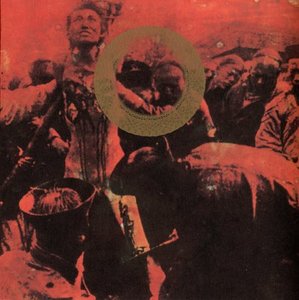
To a large extent, the image speaks for itself. As would be the case with many people, I personally find this image shocking, but the implications of the image for each viewer are, however, more complex: "I was shocked when I first experienced these images. Of course, for a white middle-class American male, these images will never mean or represent to me the same things they do for [Ellie] Hisama." (Brackett 2007: 5). Brackett is referring to Hisama's essay 'John Zorn and the Postmodern Condition' in which she berates Naked City's album Torture Garden (1989) for its use of sadomasochistic imagery and its implicit misogynistic, anti-Asian message: "[of Zorn's Torture Garden] But what of music that we don't care for, what of music that we find dull, inept, or downright repulsive? What of music that we understand to negate, devalue, or disrespect who we are?" (Hisama in Everett and Lau (eds.) 2004: 72). The article goes on to analyse a selection of Zorn's work that in some way features Asian women in a negative light. This might be through explicit means such as 'misogynistic imagery in album art, or implicitly in the music itself. The view taken by Hisama is that Zorn undermines the role of the Asian woman by depicting her as low, broken, and subordinate. This view might also be applied to images depicted in Japanese eromanga such as this image by the artist Suehiro Maruo:
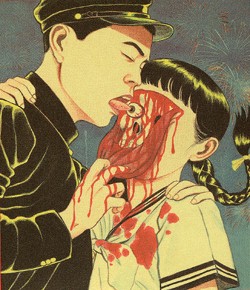
Maruo's image-which was also used in the album art for Torture Garden-is somewhat different from the artwork used in Leng Tch'e. As Brackett notes, whilst the first image is a historical document, this image is a piece of art, a cartoon. More specifically this image is taken from eromanga, a form that is widely available in Japan, though was particularly popular during the period in which these albums were released. The image's identity lies within the realms of the fantastic: "An example of the unbelievable scenario is evident even in figure 1.1 [the Maruo image], where (are we not?) expected to believe that a young girl who has just had the skin removed from her face can still manage to hug the neck of her attacker in some kind of sick embrace" (Brackett 2007: 14-15). Whilst these images appear to fit into clearly distinct categories-the fantastic Maruo image and the photograph in Leng Tch'e, which serves as a historical document-there are some images that seem to complicate the distinction:
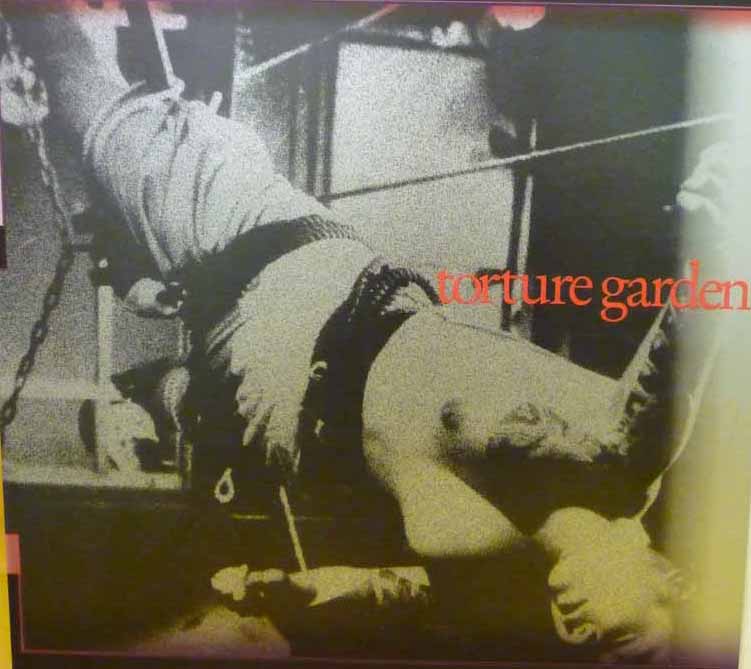
This image is also taken from Torture Garden and is a still from a Japanese 'pink' film, a low-budget softcore genre of Japanese pornography in which the depiction of rope bondage is common. This image is far more complex than the two previous images in that it is a photograph of a real situation, but is intended to be viewed as a fantasy. If one were to accept that the image is fantastic, then it is arguably far less offensive than the punishment/torture depicted in figure one.
Hisama notes that even though the images are fantastic, they still send out a negative message-about the role of Asian (specifically Japanese) women-which she feels is not healthy. One might argue that Zorn is merely using the images as empty spaces in which the viewer brings their own experiences and feelings to bear. This is not the case, however, as Zorn feels that the images and the sound are intimately connected stating that:
[f]or me, my record covers are very important. The cover has got to follow through with what the music is about. I don't just make music. I make records. I just don't give a tape to a record company + let them package it in any way they want so it sells a lot. It has to mean something. The record package is art (Brackett 2007: 175).
Brackett closes his essay by asking whom the reader identifies with when viewing these images and suggests that Hisama posits Zorn as being in allegiance with the attacker. Regardless of who Zorn identifies with, the use of the images is potentially problematic and does still, even if inadvertently, bring such issues into question.
To add another dimension to the notion of gaze in relation to Zorn's album art, the images should also be read in relation to the time in which they were created. The early 1990s symbolise a shift in Japanese obscenity law: before 1991 the law was far more ambiguous about the nature of images that could be displayed in public:
[i]n fact, many took advantage of these vagaries and ambiguities [in the law]. For example, it was possible-within the purview of the law-to show genitalia without pubic hair. Whilst this would seen to contradict article 1, No. 20 [of article 175 of the Japanese revised criminal code], it was permitted because it was understood as not being sexual, where sexual meant productive, procreative sexuality. (ibid.: 16)
The definition of obscenity here is key. It appears that the most important aspect of the law is that which protects the view of the family; anything that undermines that image in any way is subject to being labeled as obscene. This allows for an interpretation of the law in which an uncensored image of a married couple having vaginal penetrative sex is obscene, but an image of a man having sex with a pre-pubescent girl is not. This is exploited, and, rather than showing sex between two consenting adults, films of children become permissible. This non-sexual definition of imagery also extends to the notion of bodily function: "under a Shinto, rather than Judeo-Christian religious ideology, these are bodily functions that, along with burping, excretion, and picking one's nose are viewed as matters more of nature than of shame." (ibid.).
It is possible to conclude, therefore, that within the context in which the images were created, they were not intended to be, nor deemed unacceptable in themselves. The image in Leng Tch'e could be justified by arguing that the parts of the body on display are merely natural, though the connotation of the image as torture is still, of course, problematic. One might also argue however that images of human suffering and death do feature in the album art of other musical works, Rage Against The Machine's self-titled debut album (1992) comes to mind here. Further, one must also understand the way in which much eromanga imagery, both violent and non-violent was consumed publicly on an almost daily basis. This can be understood through the distribution of manga within the commuter culture of Japan's major cities during the 1990s2
Anne Allison's writing on the distribution of manga and eromanga in Tokyo outlines a culture in which a large amount of time is spent in a confined space with other people. This might be compared to the underground system in London or the Subway in New York, but unlike these systems, and due to the immensely dense nature of cities such as Tokyo, it became necessary for people to commute further and further to get to work. This created, therefore, a captive audience for several hours each day for the consumption of such literature. Manga should be viewed in this context as a somewhat disposable item. In UK cities a free daily paper called The Metro is distributed on the public transport network and it is common practice for a commuter to pick a copy of this paper up from their seat and leave it there when they have reached their destination. In Tokyo, Allison notes that manga occupied a similar role:
Not surprisingly, the routes of commuter travel have been heavily exploited by this business [the production and distribution of manga]. Not only do increasing numbers of Japanese spend increasing portions of their days commuting but also for those with frenetic schedules, the time spent travelling may constitute the only unscheduled, and in this sense "free" time in their day. For such commuters, the consumption of printed media offers the promise of both a temporary diversion to ease the length and monotony of their daily travels and a momentary escape into other worlds[.] (Allison 1996: 153)
Allison states clearly that there is a strong tie between the consumption of media such as eromanga and the notion of an escape; a journey into fantasy. This fantasy may not necessarily be based in the erotic, however, and it should be noted that a vast majority of manga is not eromanga. Furthermore, manga as a form is enjoyed by people of all ages and nationalities, and is therefore not exclusive to a Japanese readership. The Japanese response to this media however, which is to say, the free and open consumption of eromanga, creates a situation in which people may be viewing material that is labeled by some-including Hisama-as inherently unacceptable. An example of the broad nature of eromanga readership can be taken from an anecdote by Merzbow. He notes that many of the sleeves for his early cassette releases were made from eromanga taken out of the bins in subway stations, thus utilising a resource that was in abundant supply. The role of eromangamust, therefore, be understood as something that is accepted and its comsumption widespread and generally understood to be normal, at least within the subculture of Tokyo commuters. There is also, it appears, a kind of etiquette when it comes to the consumption of eromanga; an etiquette of openness. Brackett notes that
if a person reading Rapeman [a well known eromanga series] is encountered on a train or a bus, other Japanese passengers would probably sit next to him (or her) if that reader made no attempt to hide the manga. If, on the other hand, the passenger appeared to be hiding or concealing the name of the manga, other passengers would not be as willing to sit next to the reader. (Brackett 2007: 177)
The observation by Brackett suggests once again that the content of the manga-be it erotic or otherwise-is not as important as the notion that the person reading the material is engaging with in on the level of fantasy. Any kind of concealment of such material may suggest that the reader takes the content of the comic more seriously than they perhaps should. This etiquette of openness can be used to read the images in Zorn's album art: the images themselves are not an empty space into which the viewer brings their views to bear but it is rather the reader themselves who becomes the empty space on which society brings their judgement to bear. In this case the culture of consumption is more important than the content of what is being consumed.
The same reading of the social gaze can be applied to the still from the pink movie (figure three). However, this image occupies a complex space between the worlds of fantasy and of the historical/photographic. This image is perhaps most directly related to the notion of overcoming in its relation to noise music as a genre. It is interesting-if not surprising-therefore, that the images used by Merzbow in Music for Bondage Performance are of shibari and it is on this material that I will now focus.
The album Music for Bondage Performance was released as a soundtrack for a pink film and features the subtitle 'Right Brian Audile' representing the audio subsidiary of Right Brain, a Tokyo based pink film producer. The album is part of Merzbow's immense discography which to date comprises of over three hundred releases including a fifty CD retrospective entitled Merzbox, released in 2000. This output and Merzbow's music in general is perhaps most usefully read in light of Georges Bataille's notion of excess which is described by Paul Hegarty as 'not just more, but an attempt to be more, that sacrifices itself as it goes along" (Hegarty 2007, 155). This model of excess, a constant pushing and redefining of boundaries is something that links noise music to the practice of sadomasochism in general. Gini Graham Scott notes that : "[t]he boundary between what is erotic and what is not is a fine line that is always changing. And to extend beyond that boundary is exciting." (Graham Scott 1983: 156). The pushing of boundaries in the form of dominant/submissive power-play is something that is often utilised in the world of BDSM: "Everyone has his or her individual limits, the boundaries between what he or she likes or doesn't like [...] though D&Sers usually emphasize knowing and respecting the submissive's limits, because he or she is the person most vulnerable in a session, dominants have limits too." (ibid.: 155). It is important to note here that the dominant also operates within their own limits. Though the submissive might be able to outline their limits with the use of safe words and pre-agreed stopping points, the dominant's limits may involve the amount of pain that they wish to inflict upon a loved one, or indeed the level to which their dominance is subverted by the submissive. David Henry Hwang's play Bondage deals with this very dynamic when the submissive questions the authority of the dominant within the 'scene':
Mark: Well for your information ... it doesn't-it doesn't hurt that you're not in love with me.
Terri: Why not?
Mark: Because I never said that I loved you, either!
(They stop in their tracks.)Terri: You didn't?
Mark: Nope, nope, nope.(Hwang 2000: 255)
At this point in Bondage, Mark, the submissive, fundamentally undermines the dominant Terri by questioning her ability to recall what he has said. This moment marks the beginning of a complex power struggle that persists for the duration of the play. In the dynamic of the scene, this subversion by the submissive is far more uncomfortable for Terri than any kind of physical pain she inflicts upon Mark. This discomfort is not a pleasurable experience, however, as it falls outside of the boundaries of the scene; Mark has taken the scene to a place outside of the confines of bondage. It could be argued, therefore, that the bondage scene stops at this point, only three pages into the script despite the fact that the entire play is a single bondage 'scene'. This subverts the accepted practice, which is often seen to be the pushing of limits by the dominant over the submissive:
D&Sers also value the dynamic tension involved in maneuvering along the edges of a limit, and many claim the pinnacle of erotic excitement is in balancing exactly at these edges, or in trying to go beyond. On one side of the boundary, the stimulation may seem too gentle to be erotic; on the other, it becomes too intense to be pleasurable. (Grahan Scott 1983: 156)
The
constantly shifting spectrum of what is and is not acceptable runs in
line with Bataille's definition of excess as adopted by Hegarty
with regards to noise, and, specifically, to the music of Merzbow. It
seems logical, therefore, to conclude that noise and the practice of
sadomasochism can be related through the notion of excess; the
pushing, destruction, and reallocation of limits. This reading,
however, is still related to the edge of the acceptable: to exceed
the limits is to briefly step into the realm of the unacceptable,
that is until the person experiencing this excess moves their
boundary of acceptability to accommodate. One might argue that these
subjects are still on the whole unacceptable and only become
acceptable once a person's boundaries have moved. The relationship
between sound and image in Music
for Bondage Performance is,
however, two-fold, and this is important when one returns to the
notion of the unacceptable. In addition to Bataillean excess-which,
one might conclude, is still close to the notion of
unacceptability-the concept of overcoming is also important. It is
at this point that a refined distinction between shibari
and other westernised bondage practices must be made clear.
Whilst the practice of bondage from a western perspective is often conflated with the act of tying the submissive up to restrict movement during the sex act, shibari uses rope to invoke arousal through the discomfort associated with the restriction itself. The form is highly aestheticised and often involves the use of complex knots and intricate layering of different ropes. It is important to note that the type of rope used here is typically made of natural fibers: the use of materials such as hemp or jute cause far more friction than the nylon ropes used most commonly in western practices and this friction is used as another source of pain, thus heightening the erotic experience for the bound subject.
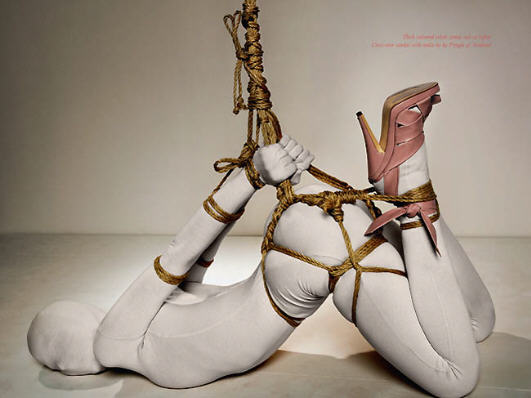
The figure shows the subject bound in a harness that immobilises both their arms and legs. Due to the position of the feet, the possibility of sexual gratification though penetration for either the dominant or the submissive subject is practically impossible. The use of a full body suit also eliminates the possibility of sexual gratification being achieved through other means, such as oral sex. This indicates a complete lack of focus upon sex acts within the practice of shibari.
Though shibari may have its roots in the administration of punishment or torture in Edo Japan, Brackett is keen to point out that there is a vital distinction to be made between the two:
Casual viewers of S/M scenes (if there can be such a thing) might easily conflate the performances of sadomasochistic behavior with real-life torture scenes. To do so, however, is to overlook some fundamental differences between the two. First, victims of torture have no say in how they are treated [...] [i]n "typical" S/M scenes, by contrast, the power resides in the "dominated" [...] Second, with torture, the infliction of pain is the means by which a torturer will gain something; the torturer gains at the expense of the victim's loss. S/M scenarios, however, more closely resemble religious asceticism where the pain undergone by the victim leads to a pleasurable experience for that victim. (Brackett 2007: 12)
In sadomasochism the submissive subject has control over what happens to them. This is administered through the use of safe words and other pre-determined boundaries. Though it is the role of the dominant to sometimes push these boundaries, this is done with the knowledge that the submissive would, in retrospect, gain something from the experience. In torture, however, the power lies squarely with the torturer. In the practice of torture, the dominant party gains something from the experience. This gain is always at the expense of the victim. In S/M, on the other hand, the experience is mutually beneficial: the submissive gains pleasure from the humiliation/discomfort of the situation and the dominant gains pleasure from their ability to cause this reaction. The construction of the situation is based in fantasy, and any overstepping of these boundaries by the dominant could have potential real world consequences; changing the scene from a compliant act of S/M to a non-compliant act of torture:
Limits change over time, sometimes by chance because a dominant pushes a submissive past what he considers a limit or because a submissive persuades a dominant to do something new [...] Yet the difference between crossing a boundary to achieve an erotic breakthrough or crossing it to produce a highly unpleasant experience can be subtle indeed. It all depends on the meaning to the participants. (Graham Scott 1983: 156)
Rather than merely a practice in the overstepping of boundaries-a movement into the unacceptable-the practice of shibari can be re-imagined as a space in which both parties allow themselves to be overcome by their actions. Vitally, however, this overcoming is not a space in which either participant experiences any kind of loss, which is to say, it is wholly distinct from the experience of the victim in an act of torture. Compliance-or, in fact, willingness- is an issue that forms the base of the liner notes in Music for Bondage Performance. Akita notes that "[t]he women present in Akita's club are there because they want to be. Their aim is not to be tortured but rather to allow his/herself to be overcome; to lose themselves without losing themselves.
To return to the sonic,Music for Bondage Performance - in terms of Merzbow's general sonic oeuvre - tends towards the mild end of the spectrum. This does not mean that the material is not extreme, however; the notion of excess is not a linear progression. Whilst other albums such as Cloud cock oo grand (1990) might be more sonically excessive, the back-stepping of limits, which is to say, releasing titles that are less sonically harsh, might be seen as a kind of inverse excess, an excess of the confines in which people attempt to pigeon hole the output of a particular artist.
Though much of Merzbow's sonic output is frankly beyond analysis-to engage in close analysis of an album such as Noisembryo (1994) would undermine the nature of its content-the track Hari-Kiri Video 'Lost Paradise' Theme: For Asako can be discussed in very basic analytical terms. The track opens with a repetitive flute-like sound that has been processed using reverb. The sample is irregular and appears to be 'glitching' as an audible click appears intermittently at which point the sample starts again. By 0'06" a heavily distorted pulsing sample begins to fade in along with overdriven guitar chords. At 0'43" the texture is further complicated by a variant of the pulsing pattern, which has been sped up and had all of the lower frequencies removed. The flute-like sample remains until 2'45" at which point it halts abruptly. By this point, however the track only has fourteen seconds remaining. Structurally speaking, the track works as a form of overcoming. The flute-like sample is attacked by a multi-layered and constantly shifting pulse-based texture, which by 2'00" has almost completely overwhelmed the original material. The flute sample is still present, however, until 2'45" when the sample appears to give up and we are left with several different pitches that evaporate with a 'pop' at 2'59".
The timbral overcoming that is present in Hari-Kiri Video is reinforced by the images contained within the cd booklet:
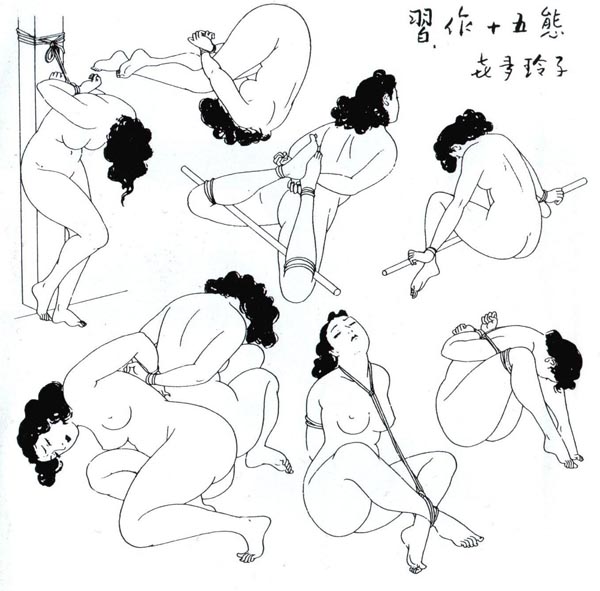
The most striking aspect of this image is that is it a series of simple sketches with no colour; there has been minimal effort taken by the artist to make this image look 'real'. It is not, however, to be confused with a manga image, an artistic tradition that comprises of many stylistic 'rules'. Furthermore, there is very little in this image that could be considered to be pornographic in nature. Though the model pictured is nude, there is minimal detail; the nipples are hinted at using a simple line, and the genitals are simply not present in the images in which it would be possible to draw them. In this sense however, the image does have similar features to some eromanga where scenes of sexual violence often lack genital detail through the clever placement of objects-this is also a common feature of 'pink' films-or through the complete lack of any genitals in the image. Alison notes that
such mass sexual tropes as voyeurism, infantilization, and sadomasochism are something other than "obscene" and other than "real". They are fantasies that can penetrate the public only by covering, effacing, and decentering the pubis. Given the depth and extent of such penetration, it might seem that obscenity laws are strangely misplaced in Japan. By proscribing genital mimesis, they allow (as not legally obscene or even sexual) the "phantasmic" reproduction of the body in practically any other form -nipple and panty shots of young girls, for example, in adult magazines and children's cartoons Thus by restricting one bodily sight/site, the state permits and stimulates the mass production of a host of others.
The images in figure five are meant more as a form of instruction, though more of the overall shape of the position of the subject as opposed to the knots and methods employed to achieve those positions. There are also photographic images within the artwork of the album, however, and these are even further removed from the notion of the pornographic:
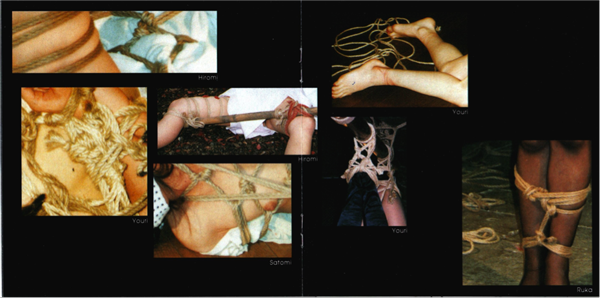
In these images, two things are immediately apparent:The body parts pictured are not pornographic in the mainstream sense of the word which is to say that they lack genital detail or even presence. The single nipple in the bottom left of the picture is not centered in the image and is therefore secondary to other aspects such as the rope.
The main focus in all of the images is the rope itself. The images focus on the specific knots used and also the way in which the ropes lie across the body.
Though the images are sexual-and in that sense may be seen as pornographic-they do not promote the objectification of women in the same way that a western bondage image might, which is to say, a pornographic image that is aestheticised by the use of rope and other fetish items such as chains, studded leather and PVC clothing.

Several aspects of this image do not conform to the form of shibari. First, the submissive appears to be enjoying herself. This goes against common practice of Japanese rope imagery in which the dominated should appear submissive and afraid. Second, the submissive is restrained using cuffs that do not cause any pain or friction on the skin. Finally, the submissive is positioned in a kind of hammock, thus allowing for a penetrative sex act to take place. This is clearly different from the previous shibari image and the penetrative sex act is clearly the focus here. This is a 'bondage aesthetic' rather than 'aestheticised bondage', which is to say, a different form of aestheticisation to the intricate rope patterns of shibari. Western bondage is aesthetic in the sense that it is an allusion to a practice, whereas shibari rope patterns are aesthetic as an integral part of that practice.
After close assessment of imagery and sound in releases by Merzbow and Zorn, it could be concluded that noise music operates in much the same way as shibari, which is to say, that it is primarily concerned with the domination of a particular party. The question one must ask now is who is dominant and who is submissive. Salomé Voegelin posits noise in sound as an excluding force, which is to say, something that overcomes the senses: "The noise deafened my senses to anything but itself [...] Noise does not only demand my attention but grasps it literally to the exclusion of all other sensorial possibilities." (Voegelin 2010: 46-47). This positions the performer as the dominator. By presenting the listener with their noise music they are overcoming and excluding them:
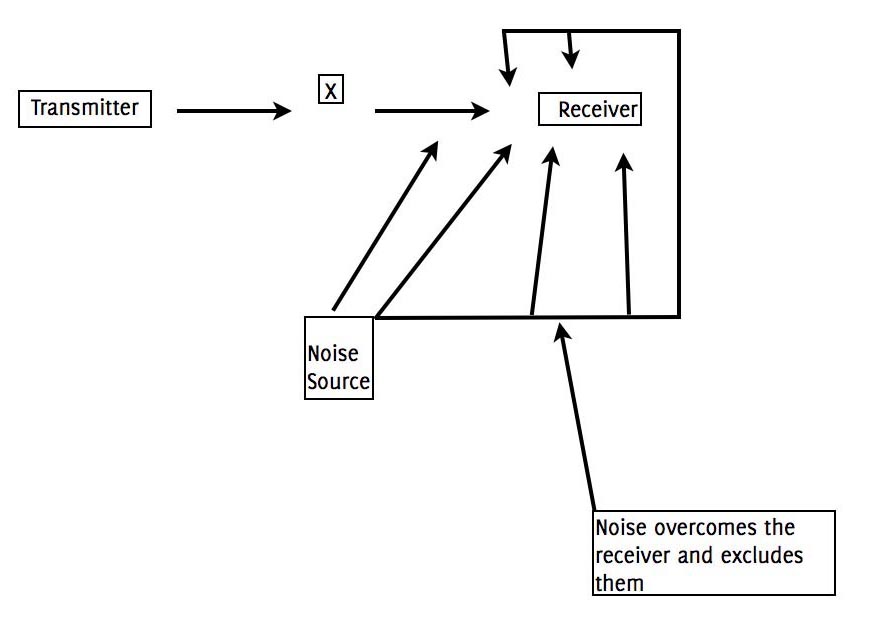
Whilst it may seem that in noise music the performer acts as dominator (figure eight), Voegelin also suggests that the performer is subject to this same excluding experience: "Noise is not necessarily an authorial act but an experimental space where the composer submits himself to the noises made." (ibid.: 48). This would create a situation in which no person is dominant, but rather it is the noise itself that is in control. Voegelin goes on to use Akita as an example: "I imagine Merzbow hooked on the noise of his own creation, unable to stop the beast that has taken over his body and only wrestling free after 50 hours and probably not even then. This abandonment is not simply a passive attitude but an active participation in the siege of noise." (ibid.). The experience of noise music in this sense, then, is a multiple overcoming by the sound itself:
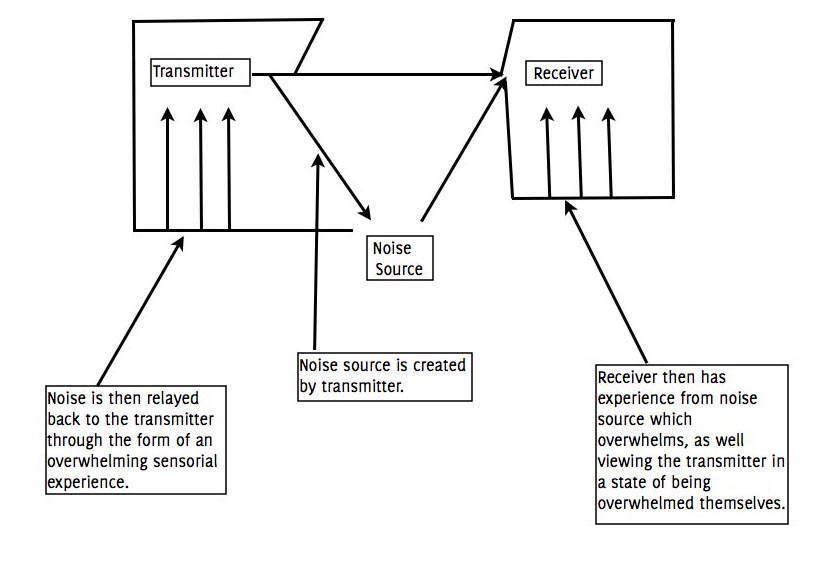
So not only does noise music resemble BDSM-particularly shibari-in terms of a human to human domination, but rather the music itself dominates the listener, allowing them to become lost in the sounds, submitting without losing their sense of self.
It would seem that, whilst noise music and shibari imagery may be linked through the notion of the unacceptable image and Bataillean excess, a line can also be drawn between the two via the notion of overcoming; an overcoming that is present in the music of Merzbow. In light of images such as those found in John Zorn's albums with Naked City, there is often a tendency to conflate BDSM imagery and noise music as being related through the notion of the unacceptable. There is also a tendency to relate the images in BDSM with torture. This, it now appears, is, in fact, a fundamentally flawed reading of the sonic visual relationship being presented here. The images are representative of a loving relationship that is dependent upon an intimate knowledge of the others likes and dislikes, as well as a deep sense of trust. If bondage strays beyond those boundaries in the knowledge that this will not be acceptable (or if the dominant does not know if this will be), then the bondage practice ceases to be bondage as such and becomes something more sinister. The violent eromanga images in John Zorn's work are to some extent more problematic for the western viewer as these seem much closer to torture, though these should be read in light of pre-1991 obscenity laws in Japan which place the destruction of the 'normal' family relationship as the pinnacle of obscenity, and the images in eromanga as knowingly located in the realms of fantasy. Noise music is ultimately connected to the practice of BDSM through the notion of overcoming, and this overcoming allows the listener/participant to let go, to transcend the situation without losing a part of themselves and to return to their own 'real' existence at their own leisure.
References
Allison, A. (1996) Permitted & Prohibited Desires, Oxford, Westview Press
Bornoff, N. (1991) Pink Samurai: An Erotic Exploration of Japanese Society, London, Grafton
Brackett, J. (2007) John Zorn: Tradition and Transgression, Bloomington and Indianapolis, Indiana University Press
Everett, Y. and F. Lau (eds.) (2004) Locating East Asia in Western Art Music, Middletown CT, Wesleyan University Press
Graham Scott, G. (1983) New York, Citadel
Harrington, L. (ed.) (2009) Rope, Bondage, And Power, Las Vegas, Nazca Plains
Hwang, D. (2000) Trying to Find Chinatown: The Selected Plays, New York, Theatre Communications Group
Langdridge, D. and M. Barker (eds.) (2007) Safe, Sane and Consensual: Contemporary Perspectives on Sadomasochism, London, Palgrave Macmillan
Matsunosuke, N. (1997) Edo Culture: Daily Life and Diversions in Urban Japan, 1600-1868, Honolulu, University of Hawai'i Press
Penley, C. and A. Ross (eds.) (1991) Technoculture, Minneapolis, University of Minnesota Press
Richie, D. (1992) A Lateral View: Essays On Culture And Style In Contemporary Japan, Berkeley CA, Stone Bridge
Woodward, B. (ed.) (1999) Merzbook: The Pleasuredome of Noise, Preston Vic., Extreme
1 There is currently very little information available on the historical aspects of such practices printed in English, see Botsman, D. (2005) Punishment and Power in the Making of Modern Japan, Princeton, Princeton University Press. For further information about the practice see, japaneseropeart.com[accessed 26/05/11] or for the contextualisation of this in kinbaku see Woodward 1999: 23-29.
2 It should be noted that the distribution of manga and eromanga has become far more international in the time since Allison's book was published. In addition to this the popularity of manga in Japan and its consumption on commuter trains has fallen in recent times. However, this article focuses on musical material that was released at the time in which Allison makes her observations and her work is therefore key to an understanding of trends in manga in relation to the period being discussed.